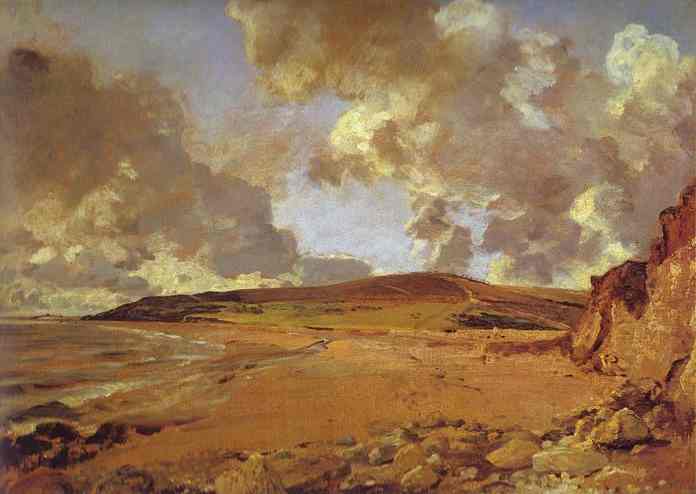The Landscapes of John Constable
 There are two difficulties with baroque landscape. First was the inclination in the 17th century baroque to represent those areas where the colour is muted in sepia. This meant that they very often gave the appearances of very deep shadow everywhere that was not the primary focus of interest. Second was the technical difficulty in describing the form of trees and foliage. It may sound like a small thing, but anyone who has ever tried to paint trees will know that they are fiendishly difficult to represent. The artist must give the sense of a united form, like a sponge, but also of one composed of many individual leaves. The paintings of trees from the earlier period tended, to my eye, to look to 'feathery'. They focussed too much on the detail and not enough on the overall form. Turner overcame this in an idiosyncratic way by adopting the colour theories of Geothe for his tonal representation and, as far as I can see, avoiding painting any trees at all! Other artists overcame this problem by representing the tonal areas in a muted version of the original colour. So, in landscape this usually means toned down greens - grey greens, blue greens, brown greens although sometimes retaining sepia for deep shadow when the composition requires it. As with Turner, the choice depends upon two factors: consideration of whether or not the area being painted is in sunshine or shadow; and how far in the distance the area is. Distance and degree of illumination both of these factors affect our perception of colour and tone and so these two variable must be reflected in any scheme that the artist devises. John Constable (1776-1837) is happy to use compositions that involve deep shadow in the foreground and he uses sepia for these areas. But he also renders areas in sunshine well. He also seemed happy to turn his hand to a wide variety of landscapes and seascapes. His watercolours or sketches, painted in situ are of interest to the modern eye (or mine at least) because of the spontaneity with which they are rendered. These would not have been considered finished works of art at the time but preparatory works for the pictures done in the studio.
There are two difficulties with baroque landscape. First was the inclination in the 17th century baroque to represent those areas where the colour is muted in sepia. This meant that they very often gave the appearances of very deep shadow everywhere that was not the primary focus of interest. Second was the technical difficulty in describing the form of trees and foliage. It may sound like a small thing, but anyone who has ever tried to paint trees will know that they are fiendishly difficult to represent. The artist must give the sense of a united form, like a sponge, but also of one composed of many individual leaves. The paintings of trees from the earlier period tended, to my eye, to look to 'feathery'. They focussed too much on the detail and not enough on the overall form. Turner overcame this in an idiosyncratic way by adopting the colour theories of Geothe for his tonal representation and, as far as I can see, avoiding painting any trees at all! Other artists overcame this problem by representing the tonal areas in a muted version of the original colour. So, in landscape this usually means toned down greens - grey greens, blue greens, brown greens although sometimes retaining sepia for deep shadow when the composition requires it. As with Turner, the choice depends upon two factors: consideration of whether or not the area being painted is in sunshine or shadow; and how far in the distance the area is. Distance and degree of illumination both of these factors affect our perception of colour and tone and so these two variable must be reflected in any scheme that the artist devises. John Constable (1776-1837) is happy to use compositions that involve deep shadow in the foreground and he uses sepia for these areas. But he also renders areas in sunshine well. He also seemed happy to turn his hand to a wide variety of landscapes and seascapes. His watercolours or sketches, painted in situ are of interest to the modern eye (or mine at least) because of the spontaneity with which they are rendered. These would not have been considered finished works of art at the time but preparatory works for the pictures done in the studio.
This is speculation on my part, but I wonder if this use of watercolour especially as the means of capturing the moment is influential the form of the finished works of the artists of this time. The finished studio based work will have been a composite of detail from a number of spontaneous sketches - and so in this case oil paint copies of watercolours. Turner almost seemed to use oil paint as though he was painting in watercolour - lots of thin washes.
Constable is one of the first that I know of to be able to render the balance of broad form and detail in foliage and trees well. He simultaneously represents the broad shape through light and dark, and provides some detail without overloading it, importantly, in a way that allows that mind to infer what the whole is comprised of. This is one of a series of article intended to read as such: Baroque Landscape Baroque Landscape: Chinese Baroque! Romantic Baroque: the Landscapes of William Turner Paintings above, from top: Lighthouse at Harwich; Wivenhoe Park
View of Salisbury
Cornfield
Weymouth Bay
Brighton Beach with Colliers




